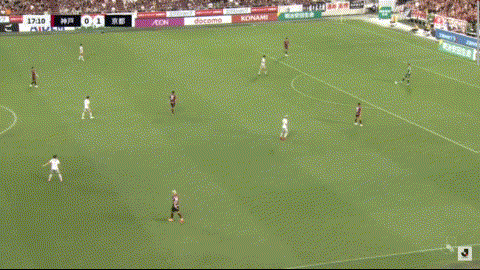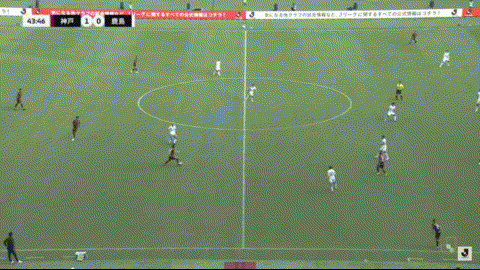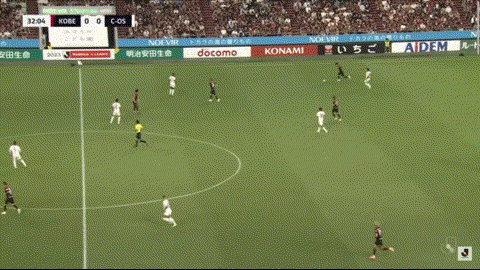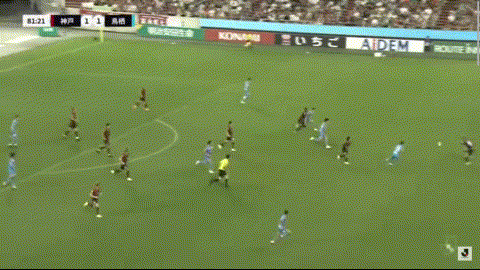Neel Shelat casts his eye over a side known for recruiting older European talent but who are now doing things very much their own way
From a tactical point of view, the J. League is right up there with some of the most interesting competitions in the world. Ange Postecoglu’s success at Celtic and now Tottenham Hotspur has helped highlight its quality to the wider world, but its tactical diversity from top to bottom still seems to go underappreciated.
Besides teams attempting to implement Postecoglu-like possession-based dominance, we have his former club Yokohama F. Marinos using a more variable style of play under Kevin Muscat which enables them to be more direct against pressing opposition, newly-promoted Albirex Niigata implementing a Brighton-like build-up structure and style, Sanfrecce Hiroshima’s expansive 3-4-3/3-4-1-2 with a very successful high press, and so much more.
As the end of the 2023 season approaches, Vissel Kobe look on course to lift their first-ever J1 League title with a relatively unique style of play – especially for a team competing at the top. At the time of writing, they are two points clear of defending champions Yokohama F. Marinos in a title race full of twists and turns where all the contenders have dropped points at numerous crucial junctures. So, although they have only averaged 2 points per game, they lead the standings – a testament to the competitiveness of the Japanese top-flight.
Some background
Before we dig into Vissel Kobe’s work this season, it is important to get some context about the club and how they got to their current state.
The club was founded in 1966 as Kawasaki Steel Soccer Club in the Okayama Prefecture, some 150 kilometres away from Kobe. They competed in the Japanese Soccer League (JSL) until it folded in 1992, leaving them in a state of limbo. A couple of years later, they reached an agreement with the city of Kobe to shift there and fully professionalise to enter the Japan Football League (JFL), at the time the division below the J. League top-flight.
They were promoted as soon as 1996 and with help from Michael Laudrup among others, but their subsequent time in the top-flight was not so successful. The club was consistently riddled with financial issues due to a variety of factors including mismanagement which led to a couple of ownership changes, in the midst of which they had a couple of brief spells in the J2 League.
It was only in the mid-2010s that Vissel began to build towards tangible success in the form of silverware. After an ownership transfer to Rakuten from parent company Crimson Group, they began to invest more and made a couple of big-name signings, starting with Lukas Podolski in 2017. Then came a flurry of ex-Barcelona Spaniards, most notably Andrés Iniesta in 2018, who was followed by David Villa and Sergi Samper.
Vissel hoped to build around this Spanish core on the road to success, hiring a number of Spanish head coaches too, including Juanma Lillo in 2018. Although they failed to break past the mid-table zone in the league, this project was not a complete failure because they did win their first major trophy in the shape of the Emperor’s Cup in 2019.
Miguel Ángel Lotina was one of the many Spanish coaches who tried to implement a possession-based style at Vissel Kobe.
After that, Vissel slowly began to move away from their little ‘Galácticos’ project. Villa retired in 2021 and Podolski returned to Europe then, with Japanese international Yoshinori Muto eventually coming in to replace them although Bojan Krkic was also signed in the same year. Vissel needed more incentive to fully change their approach, and they got just that in the shape of a relegation battle in 2022 when two Spanish head coaches tried and failed to arrest their slide before trusty old Takayuki Yoshida saved the day.
Yoshida is certainly someone who “knows the club” as the cliché goes, having spent six years there as a player quickly followed by a couple of years as an assistant coach leading up to a one-year tenure between 2017 and 2018. That was not his best work, nor was his 10-match spell in 2019, but he then went to V-Varen Nagasaki and helped the club return to promotion contention in the J2 League, so he was the one Vissel called in their time of need.
His approach to the relegation battle was to simplify things, preferring a 4-4-2 system built on defensive solidity which meant that he made the bold call to bench the ageing Iniesta. Vissel stayed up by a four-point margin so he was successful, and he felt no need to change the formula going into the new season.
Possession-Based Directness
So, Vissel Kobe have continued to take a very direct approach this season. They are second in the league in terms of accurate long balls per match with an average of 30.5, while their possession average is below 50%.
What is interesting to note about Vissel’s attitude towards possession is that it significantly varies depending on who they are facing. For instance, they kept 40% and 41% of the ball respectively in their two matches against defending champions Yokohama F. Marinos. Against relegation-threaten Yokohama FC, on the other hand, they saw 55% and 74% of the ball.
The only noteworthy change in their tactical approach, though, is that they circulate the ball around the back more against lower-table sides. Ultimately, they tend to go long in either case, rely heavily on crossing to create chances and counterpress with great intensity.
In terms of structure, Vissel Kobe always use a 4-3-3 formation. They don’t employ any dizzying positional rotations so it looks like a 2-3-2-3 or 2-1-4-3 further up the pitch depending on the position of the full-backs.
Of course, they must build up before getting there, and they have some interesting tendencies in this respect. The goalkeeper is heavily involved as the central figure while playing out from the back in a 3-3 base structure including deep full-backs, while the two number eights push on to form a front-five with the three attackers.
Vissel’s tactics are designed to work best against opponents that press high up the pitch to some extent, which covers most of the teams in the J1. Their build-up structure does not exist to play through an opposition press but rather to simply to draw it out, after which the direct aspect of their play comes into the picture. Once they see that they have drawn their opponents out sufficiently, they immediately look to play a long ball (usually through one of the centre-backs or goalkeeper) targeted to the wing on the far side, where the winger and number eight can be supported (if needed) by the advancing full-back and/or striker peeling wide.
So, this is the archetypical Vissel Kobe goal:

So, a look at goalkeeper Daiya Maekawa’s pass map from the season shows that he has played two types of passes at large: short sideways passes across the back inside his own third (including from outside the box) and then long balls targeted to either flank.
Even if their opponents elect to not press, most teams in Japan at least look to maintain a compact block and high line, so Vissel Kobe can try to replicate these tactics a little further up the pitch using one of their defenders to play the long balls. Here is an example of that:

Note the key elements of their front five in these two instances: The far-side winger trying to start a little narrow to keep open space out wide, the far-side number eight pushing up quite high to attract the attention of the opposition back line and try to free up the winger a little bit, and the remaining three entering the box at various angles to attack the cross.
However, it is not necessary that the long ball must go across the field all the time. On occasion, Vissel also mix things up with balls in behind down the line, enabling the winger to pose a threat in behind as well.
Jean Patric scores a goal to give Vissel Kobe an epic comeback!
— J.LEAGUE Official (English) (@J_League_En) September 3, 2023
Vissel Kobe [2] – 1 Kyoto Sanga F.C.
Get in now! Don't miss any moment!https://t.co/hET1V9M7cu#J30 #JLEAGUE pic.twitter.com/iJlA8K51Dk
In any case, this unique tactical setup leads to a fairly unique makeup of profiles in the XI which is worth digging into.
The centre-backs need to be press-resistant enough to play under some pressure at the back but crucially need to be adept at playing accurate long balls to find the attackers. Yuki Honda is a prime example of this, as his average of 3.78 accurate long balls per 90 at a success rate of close to 50% places him among the best in the league by these metrics, although it does bring down his overall pass accuracy to a lowly 80.25%.
Perhaps the most demanding role in this system is that of a full-back. They are not only required to start deep and act as a wide presence in the build-up, but also often find themselves releasing the long pass if they are on the near-side and going up to support the winger if they are on the far-side. At the end of it all, they are also expected to make a creative contribution in the final third.
Ryo Hatsuse has done a fantastic job in this role shuttling all the way up and down the left flank, as his heatmap nicely highlights:
We can break down his passing patterns into four types: circulatory sideways/backwards passes in his own half, progressive passes down the flank, long balls in behind across the pitch or down the line and chance-creating crosses in the final third. With these, Hatsuse’s passing effectively encapsulates what Vissel Kobe’s possession-play is all about.
It is worth going on a brief tangent and zooming in on Hatsuse’s chances created because he is Vissel’s preferred set-piece taker. Although he has put in a fair few crosses from open play, most of his assists have come from corners – highlighting Vissel’s indirect set-piece threat which has seen them score eight goals from such situations in the league so far.
On the flipside to the full-backs’ heavy involvement in all of Vissel’s possession-play is their number six. For most teams, this player is the key to everything they do with the ball, but Vissel’s style of play means he almost always gets bypassed. They have rotated a fair amount in this position for a variety of reasons, but Leo Osaki has been used there quite often. A couple of stats sum this role up quite well, as he ranks in the 99th percentile among midfielders in the league for defensive actions but has created less than one chance in two games.
We will get on to explaining his heavy defensive involvement when we move on to the out of possession aspect of Vissel’s play, but for now, his heatmap should be enough to visualise his work. Osaki is quite involved in his own half helping his side build up and goes up to support moves in the middle third but scarcely dares advance anywhere near the final third.
The number eight role in midfield also has fairly specific responsibilities. Rather than being concerned with ball progression and chance creation, these players’ primary responsibility is advancing quite a bit and supporting the wings in the opposition half. Hotaru Yamaguchi’s event maps are slightly noisy as he has been used across midfield at various times, but his primary position has been on the right so focusing on that area should provide a good idea of what his role entails.
A unique profile in Vissel’s midfield has been Daiju Sasaki. The 24-year-old has effectively served as an attacker on the left (and even been deployed on either wing occasionally), so his heatmap looks nothing like a typical number eight’s would.
He has seven goals and a couple of assists to show for his work so far.
Sasaki is third in the squad in terms of goal involvements even though he has not broken into double digits, clearly implying that they have relied heavily on the top two attackers. They happen to be two top-class players who have a good chunk of experience in Europe’s top-five leagues, namely Yoshinori Muto and Yuya Osako.
Although he was mostly used as a striker in his previous clubs, Vissel have fielded Muto on to the right of Osako this term. He perfectly encapsulates the unique requirements of Vissel’s wingers: excellent off-ball movement to get in behind, good strength and physicality to win duels and an ability to pose a serious goal threat in the box, especially while attacking crosses. Take-on ability is not that important because they rarely look to break down a low block, so the winger mostly gets the ball out wide in transitional situations (mostly chasing down long balls) when any half-decent attacker of any description can be expected to find a way to send a cross into the box.
Thanks to his fantastic and well-timed off-ball runs, Muto has regularly gotten into very dangerous situations out wide. That has been the real difficult part of his job, so his double-digit league assists tally should be primarily attributed to that rather than his creative passing.
Of course, the ex-Newcastle forward poses a big goal threat thanks to his presence and movement in the box, which in turn enables him to get into very dangerous shooting positions.
But naturally, the striker has dealt most of the damage in this regard. Yuya Osako’s similarly fantastic movement and his clinical finishing have seen him score 15 non-penalty goals this term in addition to six from the spot, so his attacking contribution cannot be overstated.
Osako alone accounts for a massive chunk of Vissel’s +8.1 xG overperformance, so their great goal-scoring success is down to supplying their most clinical finisher very well more than luck.
That sums up most of Vissel’s possession-play: circulate around the back a little bit to attract some pressure, release a long ball to the wings, send in a cross and leave it to Osako, Muto and Sasaki to make something of it. However, there is one aspect that we have glossed over so far as it transitions into the defensive side of things, so let us tackle that now.
Intense Counterpressing and Pressing
Having analysed all about Vissel Kobe’s success with a direct approach in possession, we also ought to cover what they do when their long ball does not find its mark. Of course, such passes are far less likely to be completed compared to shorter balls on the turf, so this is a significant aspect of their gameplay as well.
If you have read our earlier piece on Andoni Iraola’s Rayo Vallecano, you will be familiar with the interconnectedness between long balls targeted to the wings and counterpressing. In essence, losing the ball in advanced positions out wide leads right into counterpressing because the opposition are already boxed into a corner between the touchline and byline. Playing backwards and infield towards their own goal is very risky business with an unorganised back line, so most teams will look to go forward (even aimlessly if it comes to it) when under pressure in such situations.
Add to this the fact that Vissel have already overloaded the flank where the long ball is targeted using four players in their winger and number eight supported by the striker and full-back, and it becomes quite apparent why counterpressing has to be a natural part of their game model. Simply through their strength in numbers, they can almost always ensure that the opposition do not make it out with the ball – resorting to tactical fouling at worst.

This should explain why they have been able to rack up a whopping 610 counterpressing recoveries so far this season.
However, this visaulisation also shows that the J1 leaders are very good at pressing in settled out-of-possession situations with 356 high regains. They tend to set out in a 4-4-2 structure with Sasaki leading the line to the left of Osako, which has proven to be a very successful base for an adaptable hybrid/player-oriented approach changing from opponent to opponent.
While it's not perfect, you can see the pattern from Vissel Kobe presses, from their press trigger, focsuing on cover shadow, cause Cerezo Osaka a lot of problems. pic.twitter.com/Wyqa6B0suU
— Quan Tran Tue (@QuanTue) September 27, 2023
In the event that their press or counterpress gets played through, Vissel can look a little open at the back. This is why their defensive midfielder has to work very hard and rack up lots of defensive actions. Even so, their defensive record of 27 goals conceded thus far does not fully reflected their tally of 34.4 xGA, so they have been a little lucky in this regard.
One aspect of their defending that does deserve credit, though, is their ability and willingness to drop into a compact 4-4-2 low block when the game state makes it advisable. Not only can they soak up pressure well, but they are also able to pose a great counterattacking threat through their dangerous forwards. Thanks to those two factors, Vissel have dropped a league-low seven points from winning positions so far this season.

Discussion and Conclusion
It is worth keeping in mind that Vissel Kobe are far from the best team the J1 league has ever seen, but their shock title charge in a season when many of the traditional top sides have stumbled shows that sticking to basics and tailoring a sensible system to get the most out of a squad can be a more successful approach than rigidly sticking to one preferred style of play and trying to get everything to fall in place around that.
From a broader perspective, Vissel are yet another among many examples we have analysed that highlight the level of sophistication within the branch of direct styles of play, which often get generalised and therefore go under-appreciated. Clearly, there is no one best way to play football.
Header image copyright IMAGO / AFLOSPORT














